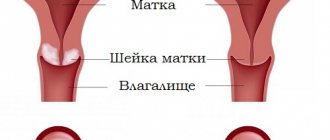To maintain health, a woman is recommended to carry out timely preventive diagnosis and treatment of gynecological diseases with regular visits to the gynecologist. In the absence of complaints and chronic pathologies, a preventive visit to the doctor is recommended annually.
A gynecological examination is the basis for determining the normal microflora of the vagina and the cellular composition of the cervix.
One of the standard gynecological procedures is the examination of the contents of the vagina and urethra for flora and oncocytology. Smears are taken from each woman.
A smear for oncocytology and flora is carried out annually in the absence of pathology, and an additional smear for flora in women with complaints from the reproductive organs.
How to prepare for the analysis?
There are several basic recommendations that must be followed before taking the test.
- You should not visit a gynecologist during menstruation. The best time to visit a specialist is in the middle of the menstrual cycle (15–17 days) or 4–5 days after the end of bleeding.
- It is important that the microflora of the genital organs remains natural. Therefore, you should not wash them with detergents before analysis, as they disrupt the acidity of the environment. You are allowed to use regular soap.
- Before taking the test, you should not use suppositories, ointments, douches, etc.
- 2-3 hours before your appointment with the gynecologist, you should not go to the toilet. Urination should be done earlier.
- Two days before your appointment with the gynecologist, you are prohibited from having sex.
- Doctors recommend taking a cervical canal test once a year.
If the above recommendations are followed correctly, a smear from the cervical canal will be successful and will show normal results.
How is the material collected?
The test is completely painless. The smear is taken on the gynecological chair using a special cervical brush - endobrush.
Before taking material for analysis, mucus is removed, and then the cervix is treated with a special saline solution. The depth of insertion of the probe into the cervical canal reaches 1–1.5 cm. When removing the probe, do not touch the walls of the vagina.
If there is ectopia, leukoplakia or other changes on the cervix, a smear is taken from them, since these disorders are background diseases for cervical cancer.
After the test, dark brown blood discharge may appear. This is a normal reaction of the body.
Neoplasm in the respiratory system
White blood cells in lung cancer, as in other cancers, are at a high level. In this case, the main indicator of a clinical blood test in the diagnosis of a lung tumor is hemoglobin, which is characterized by a low concentration. If lung cancer is suspected, a number of studies are carried out:
The fight against lung cancer is carried out by:
- surgical intervention;
- radiation and chemotherapy;
- palliative treatment (when previous methods are impossible or no longer effective).
Decoding the result
A gynecologist interprets a smear from the cervical canal. If atypical cells that lead to inflammation and other diseases are present in small quantities, the woman goes to the hospital.
In the case of a large number of atypical cells, the doctor diagnoses dysplasia, the 3rd degree of severity of which is considered cancer. In this situation, the woman is transferred to an oncologist at a dispensary.
Decoding the smear
Cancerous lesions of the male reproductive system
The prostate gland is the most important muscular-glandular organ of the male reproductive system. To determine the functional state, as well as to identify the presence and degree of the inflammatory process, the prostate secretion is examined.
Leukocytes in prostate cancer are characterized by a high content not only in the blood, but also in the prostate juice.
Diagnosis of a tumor disease includes:
- blood test for tumor marker - PSA;
- digital rectal examination of the prostate;
- transrectal ultrasound of the prostate gland;
- prostate biopsy;
- MRI and CT.
Treatment takes into account the severity of the disease, the patient’s age and individual characteristics:
- prostatectomy;
- chemo-, radio- and radiation therapy;
- drug treatment:
- hormones;
- monoclonal antibodies that allow the immune system to defeat prostate cancer;
- virotherapy is a drug with viruses that dissolve cancer cells, reduce the size of the tumor, and stimulate the immune system to fight this disease.
The most advanced forms of the disease with multiple metastases are subject to only palliative treatment.
Flora analysis result
After taking a smear from the cervical canal, the doctor deciphers the result. Normally there should be the following indicators:
| Indicators | Normal values | ||
| V | C | U | |
| Leukocytes | To 10 | Up to 30 | 5 |
| Flat (cylindrical) epithelium | 5–10 | 5–10 | 5–10 |
| Gonococci | None | None | None |
| Trichomonas | None | None | None |
| Key cells | None | None | None |
| Yeasts | None | None | None |
| Microflora | A large number of gram-positive Dederlein rods | Minor amount | Absent |
| Slime | Moderate amount | Varies depending on the menstrual cycle: from moderate to heavy amounts | Very little |
- V – data for the vagina;
- C – data for the cervix;
- U – data for the urethra.
Epithelial cells line the inside of the vagina and cervix. The cervical canal contains columnar epithelium, the norm of which reaches a maximum of 15 units in the field of view. Exceeding the norm of epithelial cells indicates the development of an inflammatory process in the organ under study in acute or chronic form. But accurate diagnostic data can only be obtained in conjunction with other indicators.
A smear on the flora from the cervical canal includes leukocytes, the norm of which is up to 30 units in the field of view. Leukocytes have a protective function, so their presence protects organs from infections and other external negative influences. When the number of leukocytes increases, an inflammatory process (colpitis, urethritis or cervicitis) is diagnosed.
The amount of mucus in the cervical canal can vary depending on the length of the menstrual cycle, from moderate to heavy amounts. It is important to tell the gynecologist the date of your menstrual cycle when taking the test.
During reproductive age, women's microflora is populated by gram-positive rods - lactobacilli. The number of these bacteria in the cervical canal is insignificant (much less than in the vagina). The presence of harmful or opportunistic microorganisms as a result of a smear indicates the presence of an inflammatory pathology.
Various cocci, fungi, chlamydia, etc., must be completely absent from the female body. Their presence indicates the development of the disease:
- yeast or yeast fungus – candidiasis;
- gonococci - gonorrhea;
- chlamydia - chlamydia;
- Trichomonas - trichomoniasis.
Only a specialist can provide correct decoding. If you have doubts about the results obtained, you can conduct a repeat study.
What are neutrophils?
Neutrophils are a group of blood cells (leukocytes). Their main function is the destruction of pathogenic microorganisms contained in the tissues of the body. Neutrophils absorb pathogenic bacteria and then die themselves.
It is the white components of the blood that are sent to the area of the inflammatory focus, no matter where it is located. And if it is in the vaginal area, white blood cells are sent exactly here. However, a smear from the uterine cervix always contains small amounts of leukocytes, but their level should be normal.
When analyzing, it is necessary to take into account the number of destroyed cells - neutrophils. The more there are, the more pronounced the inflammatory process. In addition, leukocytes in a smear before menstruation usually increase, which is associated with hormonal changes in the body. Therefore, deviation from the norm is not always evidence of pathology.
Leukocytes are not normal
If in the analysis the leukocytes do not correspond to the norm, it means that the genitals are susceptible to an inflammatory process. Depending on the quantitative structure of leukocytes, an initial diagnosis can be established, which requires confirmation by additional studies.
Increased white blood cell count
An increase in the number of protective cells in the smear indicates the presence of an inflammatory process. The greater their number, the more severe and dangerous the pathology.
An elevated white blood cell count may indicate the possible presence of a sexually transmitted disease. The causes of the inflammatory process can be the following diseases:
- mycoplasmosis;
- syphilis;
- herpes;
- ureaplasmosis;
- gonorrhea;
- thrush.
With such indicators, the gynecologist prescribes local medications (suppositories, ointments, creams, douching, etc.). If local therapy does not help, antibiotics are prescribed.
An increase in the level of leukocytes in the genitourinary system, which can reach 100 units in the field of view, can cause the development of serious diseases. Their list includes:
- endometritis (inflammation of the uterine walls);
- cervicitis (inflammation of the cervix);
- colpitis (inflammation of the vaginal walls);
- adnexitis (inflammation of the ovaries);
- urethritis (inflammation of the genitourinary system);
- cancer of the reproductive system;
- intestinal dysbiosis;
- vaginal dysbiosis.
If the number of leukocytes is very high, the doctor conducts a number of additional studies. To identify the cause, a PCR diagnostic test is prescribed. After an accurate diagnosis, rational treatment is prescribed.
The increase in the number of protective cells should not be ignored. With such results, you should definitely find the cause of the inflammation and undergo the necessary course of treatment.
Reduced white blood cell count
A reduced number or complete absence of leukocytes in a smear is a very rare case. Their complete absence may occur in old age, when sexual relations have completely disappeared.
A minimal number of leukocytes or their complete absence is dangerous for women’s health. Such indicators indicate the absolute vulnerability of the genital organs from infections and strong vulnerability to gynecological diseases. To restore the number of protective cells in the cervical canal, it is necessary to strengthen the body, namely the immune system.
To increase leukocytes you need:
- maintain intimate hygiene;
- wash your genitals regularly (every evening, before and after sex);
- use soap or other detergent that has a low acidity level for washing;
- completely abandon liquid gels for intimate hygiene, as they help completely wash out protective bacteria.
If after washing the external genitalia are dry, you need to use a cream that contains the hormone estrogen. This remedy will relieve the unpleasant symptom and also help normalize the vaginal microflora.
It is important to know that during sex the level of white blood cells increases. Consequently, a large amount of sex enhances a woman’s protective function.
If the number of leukocytes is low, the above recommendations must be followed. If this therapy does not help increase the number of protective cells, you need to consult a specialized specialist for advice.
When there is no infection, but the level of leukocytes in the smear is increased, the reasons
Diseases of the genitourinary system in women occur with a variety of symptoms. Sometimes the white blood cell count is high, but there are no infections in the body. Even in such cases, it is necessary to contact a gynecologist for examination and laboratory tests. This should be done because the number of white blood cells cannot increase on its own and most likely means the existence of pathologies in the body. A slight increase in their content is usually a sign of discomfort in the vagina or lower segment of the uterus. If the excess is small, there is no cause for concern. This sometimes occurs in medical practice. However, if the white blood cell count is significantly higher than normal, treatment must be started without delay. Do not forget that very often a general blood test shows an excessively high content of leukocytes, but in a smear they, on the contrary, are in normal quantities. This means that a pathological process is occurring in the body and you should immediately consult a doctor.
Norm of leukocytes for pregnant women
During pregnancy, the body undergoes a hormonal imbalance, which increases the level of leukocytes in the microflora of the vagina and cervical canal. Therefore, normal values for pregnant women are slightly higher.
If the increase is much greater than normal, this indicates the presence of inflammatory pathologies that need to be urgently treated. Otherwise, it can seriously harm the child:
- infection of the baby during childbirth;
- giving birth ahead of schedule;
- birth weakness;
- fetal rejection (miscarriage).
To prevent possible infection, you should take a smear for analysis once a quarter. If unpleasant symptoms occur in the form of burning, itching, redness, etc., you should immediately take a smear and conduct additional research.
After determining the type of inflammation, the woman is prescribed a course of treatment. It is important that medications are selected with great care at this time, since the wrong medication can harm the unborn baby. Therefore, this situation completely rejects any self-medication.
Intestinal tumor
In intestinal oncology, the lion's share falls on the colon. If this disease is suspected, at the initial stage tests of stool (for the presence of blood), urine and blood (leukocytes in intestinal cancer are significantly higher than normal) are prescribed.
Different areas of the intestine are examined for the presence of pathogenic cells.
If indicators indicating the presence of a neoplasm are detected, the patient undergoes other diagnostic examinations:
- palpation of the rectum;
- sigmoidoscopy;
- colonoscopy;
- irrigoscopy (intestinal x-ray);
- CT and MRI (determine the location of the tumor and help detect metastases).
Treatment methods include: surgery (removal of the tumor and nearby lymph nodes; in more severe cases, cutting off part of the intestine is required), radiation exposure and chemotherapy.











